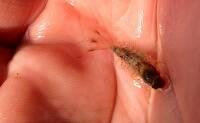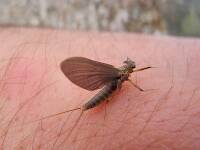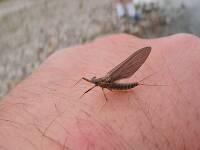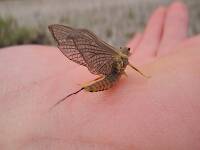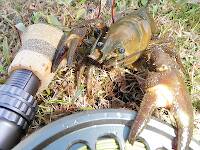
Hex Mayflies
Hexagenia limbata
The famous nocturnal Hex hatch of the Midwest (and a few other lucky locations) stirs to the surface mythically large brown trout that only touch streamers for the rest of the year.
Featured on the forum

Troutnut is a project started in 2003 by salmonid ecologist Jason "Troutnut" Neuswanger to help anglers and
fly tyers unabashedly embrace the entomological side of the sport. Learn more about Troutnut or
support the project for an enhanced experience here.
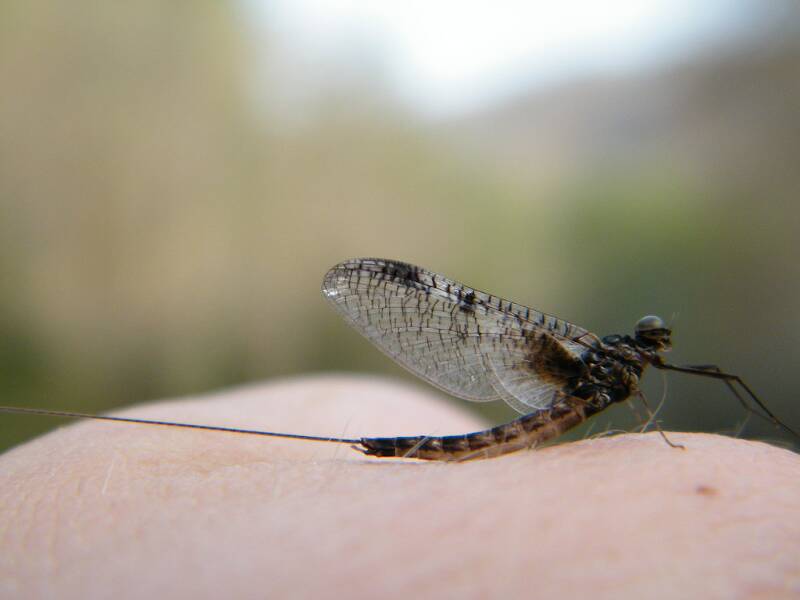
Taxon on Mar 11, 2009March 11th, 2009, 3:40 am EDT
Keith-
I would say neither. I believe the mayfly photo you posted to be of an Ameletus oregonensis male imago. Where and when was the photo taken?
I would say neither. I believe the mayfly photo you posted to be of an Ameletus oregonensis male imago. Where and when was the photo taken?
Calloway on Mar 11, 2009March 11th, 2009, 3:41 am EDT
Upstate SC a few days ago
Taxon on Mar 11, 2009March 11th, 2009, 5:35 am EDT
Keith-
Well, in that case, it may another species of Ameletus, as I believe distribution of A. oregonensis is limited to the NW. The only Ameletus species I know of in SC is A. cryptostimulus, but unfortunately, I don't have access to a description of it, as it was first recognized in 1978, 43 years after publication of The Biology Of Mayflies, the text I most heavily rely on for mayfly species descriptions.
Well, in that case, it may another species of Ameletus, as I believe distribution of A. oregonensis is limited to the NW. The only Ameletus species I know of in SC is A. cryptostimulus, but unfortunately, I don't have access to a description of it, as it was first recognized in 1978, 43 years after publication of The Biology Of Mayflies, the text I most heavily rely on for mayfly species descriptions.
Troutnut on Mar 11, 2009March 11th, 2009, 10:12 am EDT
None of the above. It's a "pseudo-gray drake," in the genus Siphloplecton. Compare with this one:
http://www.troutnut.com/specimen/253
I don't know how to tell the species apart. Siphloplecton basale seems to be the one most often mentioned in fly fishing books, but based on the distribution maps it seems some other species are more likely for your area.
The size and very early time of year match the Siphloplecton specimens I've collected.
http://www.troutnut.com/specimen/253
I don't know how to tell the species apart. Siphloplecton basale seems to be the one most often mentioned in fly fishing books, but based on the distribution maps it seems some other species are more likely for your area.
The size and very early time of year match the Siphloplecton specimens I've collected.
Jason Neuswanger, Ph.D.
Troutnut and salmonid ecologist
Troutnut and salmonid ecologist
GONZO on Mar 11, 2009March 11th, 2009, 10:16 am EDT
Keith,
I believe this is Siphloplecton basale. Ameletus would have a sharper costal angulation on the hindwing. The dark areas in the bulla and the stigmatic regions of the forewing and the dark basal 1/3rd of the hindwing are characteristics of S. basale.
I believe this is Siphloplecton basale. Ameletus would have a sharper costal angulation on the hindwing. The dark areas in the bulla and the stigmatic regions of the forewing and the dark basal 1/3rd of the hindwing are characteristics of S. basale.
Troutnut on Mar 11, 2009March 11th, 2009, 10:20 am EDT
Ooh! I win by 4 minutes! ;)
Jason Neuswanger, Ph.D.
Troutnut and salmonid ecologist
Troutnut and salmonid ecologist
Taxon on Mar 11, 2009March 11th, 2009, 12:10 pm EDT
Ah, and I stand corrected.
Troutnut on Mar 12, 2009March 12th, 2009, 8:13 pm EDT
Calloway, did you have good fishing to this hatch? When I've seen them, their numbers are always too few to provide any action on their own. They overlapped with the Hendricksons sometimes, though.
Jason Neuswanger, Ph.D.
Troutnut and salmonid ecologist
Troutnut and salmonid ecologist
Martinlf on Mar 13, 2009March 13th, 2009, 10:32 am EDT
OK, I see Gonzo is coming out of skiing exile. Glad to have you back on. Check your PM's.
"He spread them a yard and a half. 'And every one that got away is this big.'"
--Fred Chappell
--Fred Chappell
Quick Reply
Related Discussions
Topic
Replies
Last Reply
2
Feb 6, 2017
by Crepuscular
by Crepuscular






